

|
- or - How To Play With Toy Soldiers Anno 1929 |
Many wargamers think that after the publication of Little Wars by H.G.Wells in 1912, not much else happened on the wargaming front until the publications in the sixties of the book Wargames by Donald Featherstone. This is, of course, quite untrue!
One of the more entertaining books published is ShamBattle, by Harry G. Dowdall and Joseph H. Gleason, in 1929. In December 2000, I acquired a copy of this book and that's when I started building this page.
These pages explain the rules of the wargame described in the book, and show some photographs of a game I tried to play in the Spring of 2001.
Contents of the ShamBattle pages:
|
|
Inside Title Page

Table of Contents
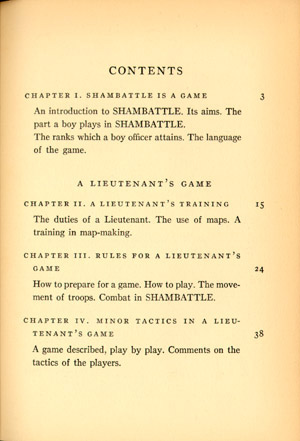
|

|
On these pages, I only give a description of the rules of the General's game. Apart from rules, there are more sections in the book, dealing with tactics and strategy, how to award medals to your soldiers etc. But the meat is definitely in the rules ... so bring them on!
|
|
Compared tro current wargaming rules, the rules of ShamBattle are awfully simple. Bear in mind, that ShamBattle is a game for boys ages 8-12, and therefore things are presented more as a game than as a simulation of war.
There are 3 games in the book: the Lieutenant's game (ages 8+), the Captain's game (ages 10+), and the General's game (ages 12+). Every game is a straightforward extension of the previous level, and merely adds some rules to it. On this webpage, only an overview of the General's game is given.
The Map
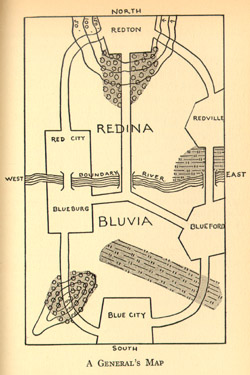 One needs a map for the game, which is drawn using colored crayons on a
3x5 feet piece of paper. The example map in the book is divided in 2 countries,
Bluvia and Redina,
which are seperated by a river. Each country has 3 cities, connected by various
roads. There are two hills, two forests, and 2 marshes. Also, there are 3
bridges where the roads cross the river. The book encourages players to draw
their own maps, and actually requires that you do so before you move up a
level!
One needs a map for the game, which is drawn using colored crayons on a
3x5 feet piece of paper. The example map in the book is divided in 2 countries,
Bluvia and Redina,
which are seperated by a river. Each country has 3 cities, connected by various
roads. There are two hills, two forests, and 2 marshes. Also, there are 3
bridges where the roads cross the river. The book encourages players to draw
their own maps, and actually requires that you do so before you move up a
level!
Placing The Troops
All the available toy soldiers are divided evenly over the two armies, such that both armies are equal in infantry and cavalry. The composition of an army is as follows:
Turns
The game is played in alternate turns. Only 5 minutes are allowed per turn. During his turn, a player may move all of his troops. After movement, all combat is resolved. The complete turn order is as follows:

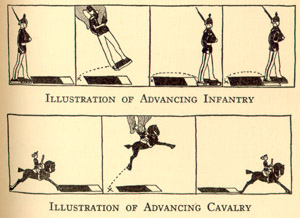 Movement is regulated by the movement marker (see picture on the left).
For each soldier to move, place the marker at the footend of the soldier,
and move the soldier forward the desired distance, as shown in the picture
on the right. Cavalry can move faster, because their base-length is usually
larger than that of infantry. The following maximum moves need to be respected:
Movement is regulated by the movement marker (see picture on the left).
For each soldier to move, place the marker at the footend of the soldier,
and move the soldier forward the desired distance, as shown in the picture
on the right. Cavalry can move faster, because their base-length is usually
larger than that of infantry. The following maximum moves need to be respected:
The cannon may be moved at the same speed of troops if two soldiers accompany it during movement. A machine gun may be moved when one soldier is next to it. Two medical men may move a field hospital until it is finally deployed.
Melee
If a general has one of his soldiers touching an enemy soldier after all movement has been finished, he can call for a bayonet combat if it is his turn. Two or more soldiers may be touching a single enemy soldier, and then multiple combats may be called for. For each combat, both players roll a die simultaneously, and the outcome is determined as follows:
Soldiers cannot enter combat with medical corps men.
Partial casualties cannot move, and cannot engage in any combat until treated in a hospital.
Cannon and Machine Guns
Each cannon and machine gun can be fired only once per turn.
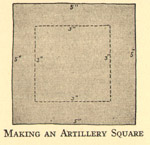
 In order to fire a cannon, two men need to touch it. The cannon can shoot
anywhere on the map. An artillery square (measuring 3" by 3", and cut out
of wood, using a larger 5" by 5" square) is placed at the desired location,
and then a die is thrown. All soldiers completely or partly covered by the
artillery square are destroyed on a roll of 1 if they are in the open, and
are a partial casualty if they are in the forest or in a city. Any other result
means the soldiers are unharmed.
In order to fire a cannon, two men need to touch it. The cannon can shoot
anywhere on the map. An artillery square (measuring 3" by 3", and cut out
of wood, using a larger 5" by 5" square) is placed at the desired location,
and then a die is thrown. All soldiers completely or partly covered by the
artillery square are destroyed on a roll of 1 if they are in the open, and
are a partial casualty if they are in the forest or in a city. Any other result
means the soldiers are unharmed.
Machine guns are used in a similar way, but now a triangular template is used. The size of the triangle is 1.5" for the base, and 2" for its height. In order to fire a machine gun, one men need to touch it. The gun can be turned in any direction. Place the apex of the triangle at the gun, and any soldiers covered by the triangle are hit. Troops in the open are killed, but troops in cities or in a forest are only partial casualties.
Cannon and machine guns cannot be targeted at medical corps men or hospitals.
Cannon and machine guns can be captured if you are touching it with your soldiers, and no enemy soldiers are touching it. You can then use the gun or cannon as one of your own.
Hospitals
 Each army has 6 medical corps men and 3 hospitals. The main hospital has
to be deployed at the beginning of the game, but the field hospitals can
be moved until deployed.It takes 2 medical corps men to move a field hospital.
Once a hospital is deployed, a medical corps men must be in the hospital
at all times. The three other medical corps men can be used to bring partial
casualties to the hospitals.
Each army has 6 medical corps men and 3 hospitals. The main hospital has
to be deployed at the beginning of the game, but the field hospitals can
be moved until deployed.It takes 2 medical corps men to move a field hospital.
Once a hospital is deployed, a medical corps men must be in the hospital
at all times. The three other medical corps men can be used to bring partial
casualties to the hospitals.
A medical corps men can move a partial casualty just as he would move a machine gun. Once brought to the hospital, the casualty is placed in the hospital, and can be moved again next turn. A hospital can only treat 2 casualties each turn.
Spies
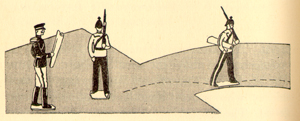 At the beginning of the game, every player picks a spy in the opposite
camp (an easily recognizable soldier), and writes his identity on a sheet
of paper. This sheet is then placed in one of the border towns.
At the beginning of the game, every player picks a spy in the opposite
camp (an easily recognizable soldier), and writes his identity on a sheet
of paper. This sheet is then placed in one of the border towns.
The spy papers can be moved by a soldier in the same way as a cannon or machine gun is moved. If the enemy captures the spy papers, he knows the identity of the spy.
At any time during his turn, a player can reveal the identity of his spy.
The soldier then acts as a soldier for that army during the remainder of the
game.
On to the Game as played anno 2001!

Home | This
page was written by
Phil
Dutre
and
is
maintained
by Bart
Vetters Schild en Vriend Miniature Wargaming Club Leuven |